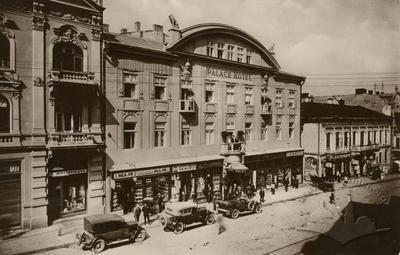
Palace Hotel
- ID: 1569
- Place: Chernivtsi
- Date: 1930-1938
The postcard shows a part of the building of the Residence of the Greek-Orthodox Bishop in Chernivtsi. From 1873 on he was the Metropolitan of the Bukowina and Dalmatia, being the head of all Orthodox believers in the Habsburg Empire. The impressive structure was buit between 1864 and 1882 and replaced an older residence from the 1780s. It sits on a hill overlooking the city. In the 1880s the top of this hill behind the gardens of the Residence got the name Habsburgshöhe. The driving force behind the project was Bishop Eugen Hacman, the architect was Josef Hlavka from Bohemia. The necessary amount of 1,75 million Guilders came mainly from the funds of the Greek-Orthodox Church of the Bukowina (Griechisch Orientalischer Religionsfonds). The ensemble in moorish-byzantine style consists of three wings which surround an inner courtyard: the central Bishop’s residence, the Seminary with a church to the left and the monastery on the right side. Behind the Bishop’s residence there is a large private garden. The postcard shows the entrance gate to the inner courtyard, parts of the central buildung and the seminary building with the seminary church on the left side. This building housed the greek-orthodox seminary, founded in 1828, and the theological faculty ot the university of Chernivtsi which attracted students from all over the Empire, south-eastern Europe and the Middle East. Teaching took place mostly in Romanian language, sometimes in German and Ukrainian. The reputation of the institution was high, at the eve of World War one it had about 200 students. The Seminarkirche (seminary church) of the Three Holy Hierarchs was consecrated in 1882, the inside wall paintings were done by the Viennese Karl Jobst. The tiles of the roof reflect colours and designs of folk art of the Bukowina. After the second Wold War, the orthodox seminary was closed, the Bishop moved to Romania and the building, which was severely damaged by fire during the war, was handed over to the University of Chernivtsi, as main building of which it serves until today. The seminary church was used as a storage room by the Soviets, the wall paintings and the iconostasis could be saved. Today the church is restored and very popular for weddings. The postcards also shows the street leading to the Residence from the city center. Originally named Bischofsgasse, it was called Residenzgasse later, and University Street nowadays. The bus is most likely a FIAT purchased in the 1930s.
Helmut Kusdat